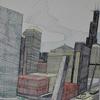"Scandal"
- May 07, 2012 17:04
When he wasn’t painting, Hudson River School artist David Johnson loved to draw, with confident lines on big sheets. Every once in a while his pencil traced the figure of a woman.
For example, in an 1886 drawing (above), a woman in full dress looks out over a pond in the Adirondacks. In lieu of a visible expression she appears self-possessed, as though lost in thought. In the forested background, meanwhile, is seen the shadowy and skulking figure of a man.
The scene can be thought of as an unintentional metaphor: hidden in the trees of the Hudson River School artists lurked passion, restrained.
Cole, Church, et al., steeped in Romantic poetry and painting, and an extension of the Romantic Movement themselves, are ironically known for their formality in life as well as art.
This may be due to a culture of refinement and restraint that characterized their social milieu. It also may be due to our inability to know the full reality of their lives: what happened in the 19th century may well have stayed in the 19th century.
Whatever the case, far from being artistic demigods ennobling the citizenry with visions of the sublime, the Hudson River School artists were just as human as those who came before, and after. The curtain is pulled back on their lofty reputation, if slightly, in a letter sent by artist Jervis McEntee, viewable online in the Digital Collections of the Metropolitan Museum of Art Libraries.
In September 1858, McEntee and fellow artist John Williamson were engaged in a sketching trip in the Catskills. Writing to an un-named recipient (possibly engraver and art collector/dealer Samuel Putnam Avery) McEntee indulged in some small-town gossip.
Having passed through Hurley, New York, McEntee wrote, “[David] Johnson is at the Hurley Hotel, but under such unpleasant and suspicious circumstances that neither Williamson nor myself consider it prudent to associate with him.”
In the late 1850s Johnson, like McEntee and Williamson, was trying to make his name as a landscape artist. He was familiar with the Catskills, having sketched there as early as the late 1840s with John Frederick Kensett and John Casilear (the Hurley Hotel where he stayed still exists today, renovated and renamed "The Hurley Mountain Inn").
“The fact is,” continued McEntee, “that he has a female companion with him who I fear is not just what she ought to be. At least they have made themselves the subject of village scandal.”
Whether McEntee knew of further circumstances in the matter or whether he allowed himself to be drawn into the “village scandal” is hard to tell.
“I am sorry for I thought I should like David and had invited him to come to my house, but after such a bare faced and scandalous act as to bring a disreputable woman with him, knowing that he was to meet Williamsons and my wifes, besides getting me to recommend him to a boarding place, I think I have done with him.”
McEntee set high standards for friendship, and would withdraw it temporarily if he felt slighted—as Worthington Whittredge, Eastman Johnson, and John Ferguson Weir each found out in the 1880s.
Johnson, for his part, apparently felt no need for secrecy. After all, if he wanted a clandestine romantic liaison, the fishbowl of a rural hamlet was hardly the place for it.
She may have even posed for him. A drawing by Johnson done in Hurley that September, now in a private collection, shows a farmhouse on a hill above a pond. A small figure, probably a man, ascends the hill on a path. On the right side of the pond stands the much-larger figure of a woman in a full-length dress, holding what looks like a ribbon from her wide-brim sun hat, gazing off to her right.
No farmgirl, she. Yet on paper, seemingly a figure of grace rather than impropriety.
McEntee didn’t think so. “It is barely possible that there may be more of indiscretion than guilt,” he wrote, “but certain circumstances which have transpired leave very little room for charitable doubt in my mind.”
It seems that McEntee’s contempt eventually softened, as it usually did. In 1869 Johnson married Maria Louise West of New York City, who may or may not have accompanied him in Hurley eleven years earlier. Regardless, they were both invited to, and attended, an 1872 party organized by McEntee in honor of Asher Durand.
Meanwhile, Johnson continued to draw to the end of his career, with the figure of a woman occasionally gracing his pastoral scenes. Thus even the dignified world of the Hudson River School was not entirely devoid of Eros, suggesting a new take on the phrase, "Et in Arcadia Ego."
Sources:
Baur, John I. H., and Margaret C. Conrads. Meditations on Nature: The Drawings of David Johnson. Yonkers, NY: Hudson River Museum of Westchester, 1987.
“Jervis McEntee letter to unidentified recipient, 1858.” Digital Collections, The Metropolitan Museum of Art Libraries. The Metropolitan Museum of Art, n.d. Web.





















